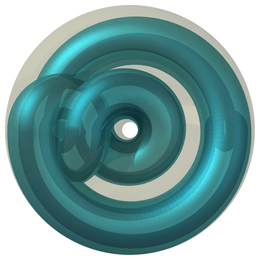Whitehead manifold
In mathematics, the Whitehead manifold is an open 3-manifold that is contractible, but not homeomorphic to . J. H. C. Whitehead (1935) discovered this puzzling object while he was trying to prove the Poincaré conjecture, correcting an error in an earlier paper Whitehead (1934, theorem 3) where he incorrectly claimed that no such manifold exists.

A contractible manifold is one that can continuously be shrunk to a point inside the manifold itself. For example, an open ball is a contractible manifold. All manifolds homeomorphic to the ball are contractible, too. One can ask whether all contractible manifolds are homeomorphic to a ball. For dimensions 1 and 2, the answer is classical and it is "yes". In dimension 2, it follows, for example, from the Riemann mapping theorem. Dimension 3 presents the first counterexample: the Whitehead manifold.[1]
Construction
Take a copy of , the three-dimensional sphere. Now find a compact unknotted solid torus inside the sphere. (A solid torus is an ordinary three-dimensional doughnut, i.e., a filled-in torus, which is topologically a circle times a disk.) The closed complement of the solid torus inside is another solid torus.

Now take a second solid torus inside so that and a tubular neighborhood of the meridian curve of is a thickened Whitehead link.
Note that is null-homotopic in the complement of the meridian of . This can be seen by considering as and the meridian curve as the z-axis together with . The torus has zero winding number around the z-axis. Thus the necessary null-homotopy follows. Since the Whitehead link is symmetric, i.e., a homeomorphism of the 3-sphere switches components, it is also true that the meridian of is also null-homotopic in the complement of .
Now embed inside in the same way as lies inside , and so on; to infinity. Define W, the Whitehead continuum, to be , or more precisely the intersection of all the for .
The Whitehead manifold is defined as , which is a non-compact manifold without boundary. It follows from our previous observation, the Hurewicz theorem, and Whitehead's theorem on homotopy equivalence, that X is contractible. In fact, a closer analysis involving a result of Morton Brown shows that . However, X is not homeomorphic to . The reason is that it is not simply connected at infinity.
The one point compactification of X is the space (with W crunched to a point). It is not a manifold. However, is homeomorphic to .
David Gabai showed that X is the union of two copies of whose intersection is also homeomorphic to .[1]
Related spaces
More examples of open, contractible 3-manifolds may be constructed by proceeding in similar fashion and picking different embeddings of in in the iterative process. Each embedding should be an unknotted solid torus in the 3-sphere. The essential properties are that the meridian of should be null-homotopic in the complement of , and in addition the longitude of should not be null-homotopic in . Another variation is to pick several subtori at each stage instead of just one. The cones over some of these continua appear as the complements of Casson handles in a 4-ball.
The dogbone space is not a manifold but its product with is homeomorphic to .
References
- Gabai, David (2011). "The Whitehead manifold is a union of two Euclidean spaces". Journal of Topology. 4 (3): 529–534. doi:10.1112/jtopol/jtr010.
Further reading
- Kirby, Robion (1989). The topology of 4-manifolds. Lecture Notes in Mathematics, no. 1374, Springer-Verlag. ISBN 978-0-387-51148-1.
- Rolfsen, Dale (2003), "Section 3.J.8.", Knots and links, AMS Chelsea Publishing, p. 82, ISBN 978-0821834367
- Whitehead, J. H. C. (1934), "Certain theorems about three-dimensional manifolds (I)", Quarterly Journal of Mathematics, 5 (1): 308–320, Bibcode:1934QJMat...5..308W, doi:10.1093/qmath/os-5.1.308
- Whitehead, J. H. C. (1935), "A certain open manifold whose group is unity", Quarterly Journal of Mathematics, 6 (1): 268–279, Bibcode:1935QJMat...6..268W, doi:10.1093/qmath/os-6.1.268